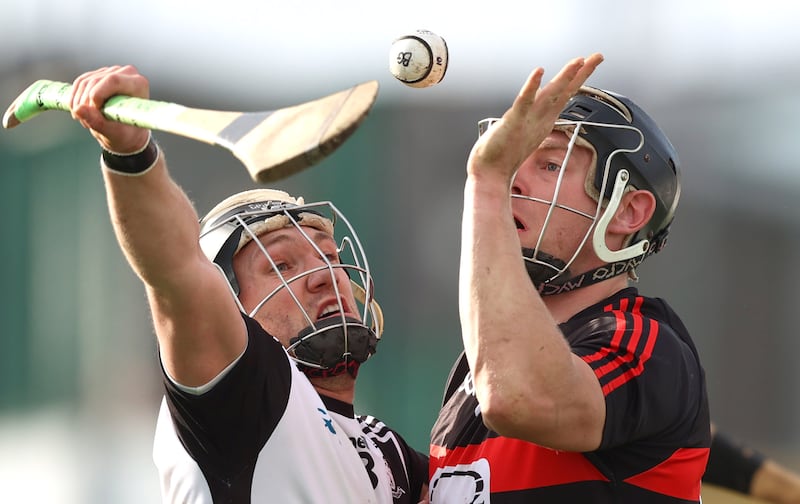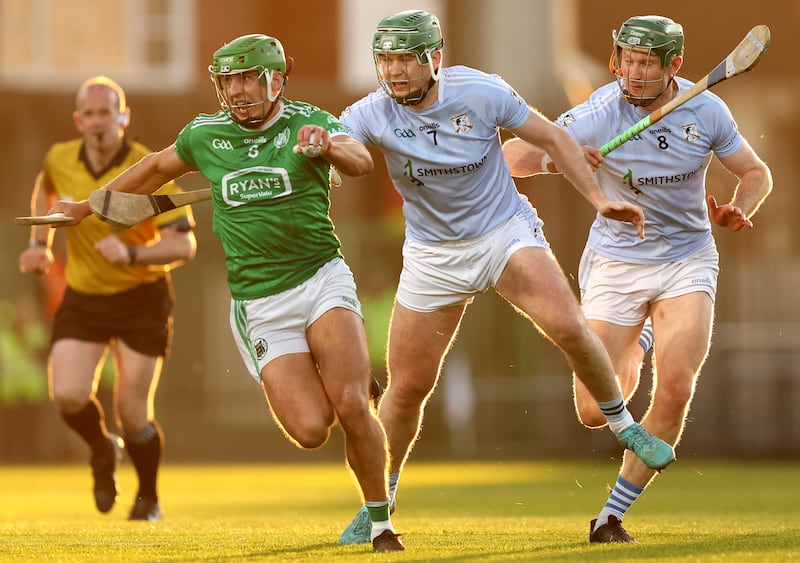Sunday in Walsh Park and the champions are up and running. Ballygunner have transitioned from being a big noise in Waterford to occasional provincial winners to last February becoming the county’s first winners of the All-Ireland.
That status sits lightly with them. They hadn’t played competitively in eight weeks but such was the speed and cleverness of their play that you wouldn’t have known.
Dessie Hutchinson, last season’s player of the championship, as usual caught the eye. His Velcro touch and ability to magic out scoring space with a couple of steps had evidently been uncompromised by the long interval since his previous match.
When he turned creator in the second half, the darting runs to the corner followed by passes flashed across to onrushing team-mates opened up Kilruane.
Commemorating 50 years since Dublin came in from the cold in under-21 football
High-flying Barry O’Connor raises his game to keep St Martin’s in the hunt for silverware
Hurling round-up: Clough-Ballacolla set up tasty semi against Henry Shefflin’s Shamrocks
Football round-up: Conor McAteer leads Newbridge attack against Madden to reach Ulster Club semi-final
TG4 commentator Mac Dara Mac Donncha said that on one occasion last year, it was noticed that on a 15-metre run, Hutchinson twice looked left and twice right before executing a pass, all in a frame of seconds.
Whether it was a legacy of the professional soccer past, he always looks aware of players’ positions and the next play’s smartest disposal.
It’s a puzzling aspect of the club championships that, as matches move into a more important sphere, crowds get smaller or in Spinal Tap phraseology “their appeal becomes more selective”. Stripped of the visceral thrills of county finals, fixtures appear to fade from the consciousness.
The 1,621 who turned up would have noted the menace of the champions but also had warm thoughts for the Tipperary representatives who were on a third match in 15 days, the previous two a county final and replay, as they concluded a memorable season and a first county success in 37 years.

Within the GAA, however, crowds aren’t always a barometer of either quality or importance. For example, Fitzgibbon and Sigerson Cup matches frequently showcase the best young talent in the country and some of the most innovative and influential coaching but the third-level championships are no place for the agoraphobic.
Club championships may gut-punch only the truly committed but when exceptional teams start to rumble there’s always a keen interest among followers in general, as reflected in the growing television audience once the provincial and All-Ireland campaigns start to move.
Hurling is about to stage one of those club contests that will break the fourth wall and engage those outside of the two communities involved.
Ballygunner’s impressively smooth return to the playing field at the weekend may only buy a further two weeks in the championship. On Sunday week they have to go to Limerick to take on Na Piarsaigh.
If the All-Ireland can be reduced to the two Munster clubs and Ballyhale Shamrocks – as the bookies do with just St Thomas’ featuring alongside in the betting, as they are just one match, the Galway final, from reaching the All-Ireland series – in less than a fortnight it will be down to “one from two” rather than “one from three”.
The champions are a phenomenon all the same. Urban or suburban clubs benefit from the onwards drift to population centres and the few miles that made Ballygunner a village outside of Waterford when the club was founded in 1954, have long been consumed by movement in both directions.
Since the tills began to ring for the club with a first county championship of the modern age in 1992, Ballygunner have won more than half of the titles since. Their dominance extends beyond senior. They are currently intermediate champions and have won the past three under-20 titles.
In one juvenile tournament, the club won the first, third and fourth of the four divisions. At senior level they have equalled the record of nine successive county championships, held by Erin’s Own in the 1930s and Mount Sion up to 1961.
With Na Piarsaigh, they have dominated the Munster club scene in the past 10 championships, winning six titles.
More strikingly, the two clubs brought home the province’s only two All-Ireland titles in the past 19 years: Na Piarsaigh in 2016 and Ballygunner last February when Harry Ruddle’s stunning, last-second goal stripped Ballyhale of their three-in-a-row, leaving them no time to recover.

That is another layer of the subplot. This season, the Munster champions play Leinster in the semi-finals, making either a rematch of that dramatic finale or a revisiting of this year’s intercounty All-Ireland between Limerick and Kilkenny the most likely prospect.
Ballyhale have been on their own trajectory, a first ever five-in-a-row in their jubilee year and reaching joint-top of Kilkenny’s roll of honour with Tullaroan having given them a 90-year start both in terms of foundation and first title won.
In the Kilkenny final, they lost Paddy Mullen to a red card and still mastered James Stephens. After last year’s trauma, they look like they’re on a mission. If they succeed, it will be the first time a club has won the Tommy Moore Cup having lost the previous final.
These three clubs account for four of the last six All-Irelands and all have attacks that wouldn’t be out of place at intercounty level but one of the three won’t be around for much longer.
There’s won’t be as much hanging around either. This year the All-Ireland semi-finals are happening before Christmas so there’s nowhere to lose provincial form along the way.
Football’s semi-finals are being held over but only until early in January so the season is slowly becoming more compact even if there are genuine reservations about the possibility of getting both championships done in the calendar year.
It’s safe to say that the club championship has our attention.
sean.moran@irishtimes.com


















